In a day and age where transparency is so valuable for brands, positive reviews are make-or-break for your business.
Don’t take our word for it, though.
A staggering 95% of consumers read reviews before making any sort of purchase online. Those customers’ trust in reviews is at an all-time high versus traditional ads.
If you think about it, this phenomenon makes perfect sense.
Consumers want peace of mind, plain and simple. This is especially true if they’re interacting with a brand for the first time.
With so much competition in any given space online, a slew of reviews really can seal the deal.
Here’s the catch, though: simply having reviews handy isn’t enough.
Brands need a specific system where they’re regularly curating compelling reviews to prove just how much they’re worth.
And arguably the most underrated place to score those reviews is your own email list.
The 6 Email Campaigns You Can Use to Improve Reviews
Food for thought: your email subscribers represent satisfied customers.
They know you. They trust you.
And therefore they’re prime candidates for producing positive feedback on behalf of your business.
The good news? Acquiring those precious ratings and reviews is easier than you might think.
Below are six strategies for beefing up your business’ reviews via email. From small tweaks to your current campaigns to review-specific messages, any combination of these tactics is fair game.
1. Send Follow-Up Purchase Autoresponders
Spoiler alert: scoring reviews doesn’t have to be complicated or time-consuming.
That is if you’re putting the process on autopilot.
Chances are that you’re already using email autoresponders to nurture subscribers through offers, deals and newsletters, right?
Consider throwing a post-purchase autoresponder into the mix that asks for a review, too.
Post-purchase autoresponders are a brilliant way to put much of your review curation process on autopilot. Instead of chasing after reviews, customers are asked to leave their feedback automatically.
Helping to increase your customer lifetime value, post-purchase emails are likewise hard for your subscribers to miss. In fact, such messages receive double the open and click-through rates of typical marketing emails.
There is no “right” way to ask for a review post-purchase: it all depends on your brand and how specific you want to get with your reviews.
Will a star-rating suffice? Looking for a bit more detail? The choice is up to you.
Below is an example of how you can put together a review-centric drip campaign to encourage on-site reviews, third-party platform reviews or both.
To begin, businesses can shoot off a “thank you” autoresponder immediately after a transaction or completed sale takes place.

Days later, a follow-up message is sent if the customer doesn’t initially comply with the first request.

And a week after the original message, the customer receives one last invitation to review.

This combination of messages helps cover your bases to ensure you’re receiving the most reviews possible. Scheduled in advance, they can be timed in such a way that they’re sent while your brand is still fresh in your customers’ minds without coming across as desperate.
Again, these are some of the messages your customers are most likely to see post-purchase. Make them count. Putting them on autopilot means you’re winning an opportunity for a stellar review every time you win a sale.
2. Curate Reviews from Your Best Customers
Some businesses might be wary of asking for reviews from each and every customer.
Hey, we get it.
Maybe you’re wary of negative feedback from customers.
Or perhaps you want to test the waters with a smaller group of customers to figure out the best way to ask.
And hey, who better to ask than your most loyal fans?
Remember: your email list represents a direct line between your business and its most satisfied customers. These include your brand advocates, big spenders and repeat buyers.
These are the folks who are more than happy to write you a review. They’re also extremely likely to give you glowing praise.
By segmenting your email list, you can automatically organize who your best customers are at a glance. Some parameters you can set with the help of your email solution and CRM include…
- Customers who’ve spent the highest dollar value over time
- Customers who’ve clicked the most through your most recent emails
- Customers who’ve most frequently visited your website or product pages
- Customers who are spending the most time on your website
- Customers who’ve replied to the most emails or social messages
These segmentation features are fairly commonplace and make it easy to put together review curation campaigns from scratch.
For example, Mailchimp’s advanced segmentation allows users to organize and list their “best customers” based on set parameters. With these data points in mind, you can blast “for your eyes only”-style messages that’ll make those top customers feel like a million bucks for being considered.
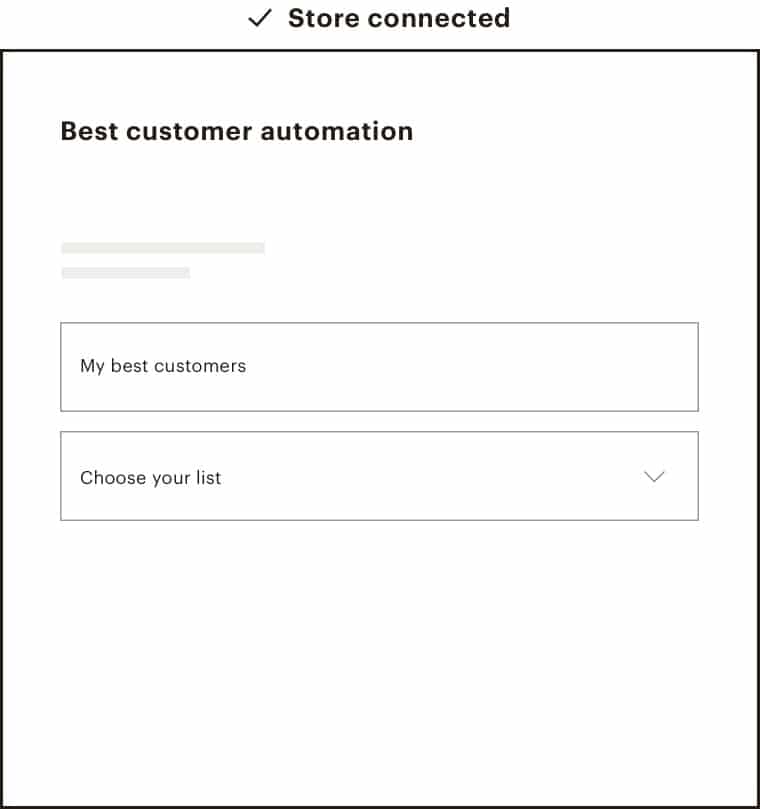
This tactic can allow you to build some confidence as you start asking around for reviews. Again, doing so can be understandably awkward or uncomfortable. By sending personally tailored messages to people who already know and trust you, there’s little reason to second-guess yourself.
3. Showcase Your Social Following
For this tip, consider how email can be used in tandem with social media to build a stronger base of reviews.
How so? Well, note that social media is a prime place to curate user-generated content (UGC). This includes customer photos, review snippets and feedback which today’s customers absolutely prefer to old-school ads. These forms of social proof are proven to boosts conversions.
And fun fact: 50% of consumers want to be told to create such content on social media.
Branded hashtags and asking for customer photos or feedback directly is totally fair game on social media. Doing so only takes a single organic post.
So if you want to get someone to take a snapshot with your product or pen a quick review, social’s a great place to do it.
Of course, this means pushing your email traffic to social media. Businesses should consider tactical ways to funnel subscribers to their social feeds so you can reach them beyond their inboxes. This means more long-term engagement and therefore more loyalty.
How do you move those customers from Point A to Point B?
Start by putting your social feeds front-and-center via email.
Brands like Bellroy advertise their Instagram as part of their welcome emails. It’s somewhere they spend a lot of time and energy: they understandably want customers to check it consistently out for new products and updates.
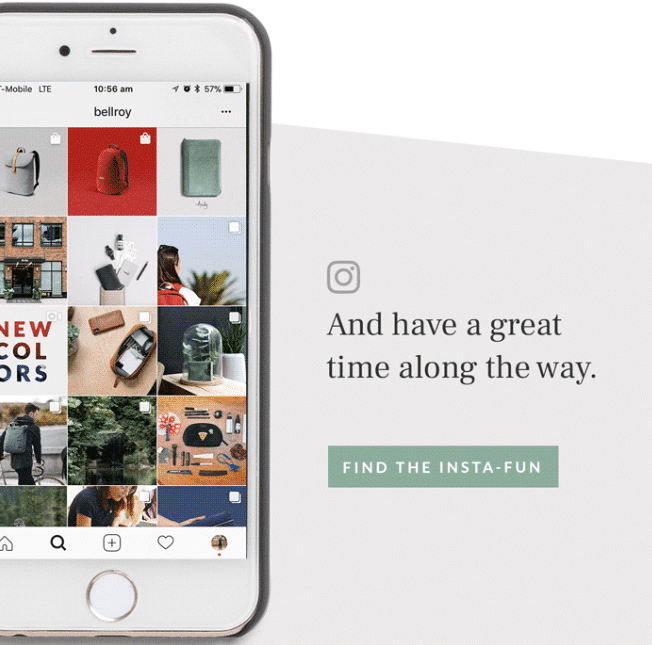
To reinforce this, they couple every email with their branded hashtag and links to their social channels.
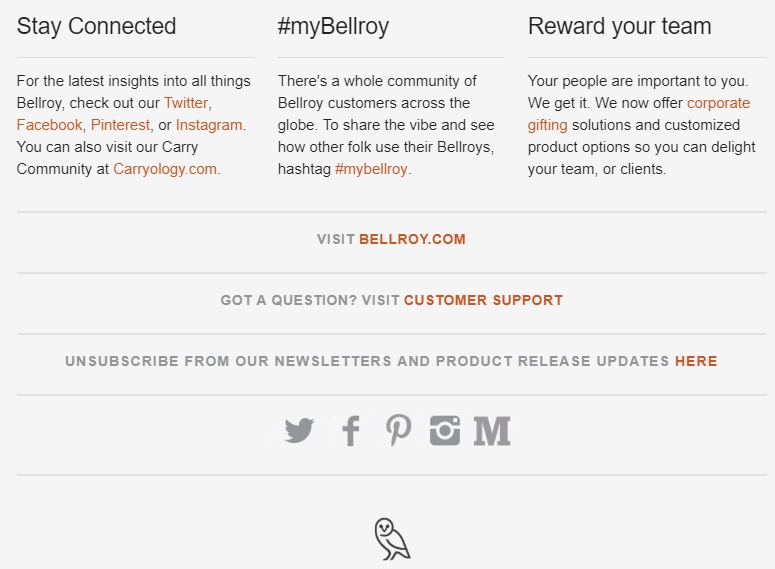
And guess what? Their promotional tactics pay off. There are thousands of fans sharing their latest purchases on Instagram using the hashtag #myBellroy.

Example of a fan sharing the hashtag on instagram.
These photos are great social proof on their own but are also perfect for supplementing reviews. For example, Google Reviews and Yelp! Listings allow customers to upload user-generated content.
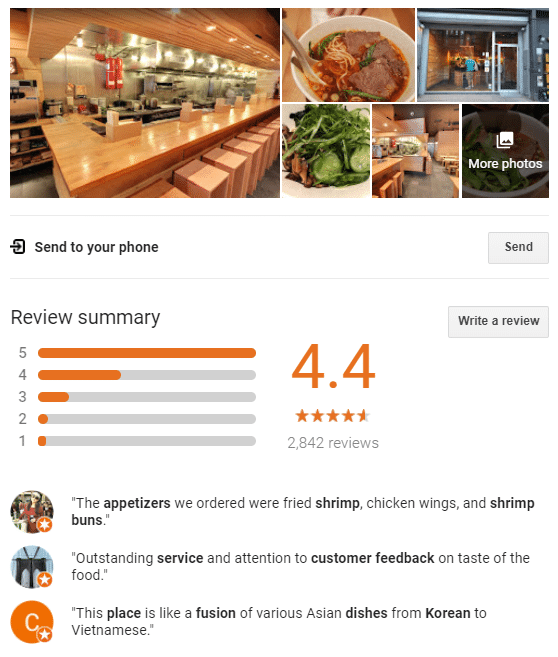
Businesses can use them in advertising as well, granted you ask for them. Take time to understand how to ask explicit permission for UGC so you can harness some of your business’ most valuable marketing firepower.
And hey, that leads us directly to our next point.
4. Customer Showcase Campaigns
Once you have existing customer photos, reviews or testimonials, you can use them throughout your email marketing campaigns to encourage more of them.
For example, you can share customer stories and include a call-to-action that asks for subscribers to respond with their own sales as well. This is a personable, pressure-free way to ask for long-form feedback and score some valuable customer stories in the process.
Customers want to create content and be featured as part of your campaigns. What better way to show your human side than by putting the humans that support your business front-and-center?
5. Freebies, Contests, and Giveaways
REALLY BIG CAVEAT HERE:
Under no circumstances is it appropriate to ask for a positive business review in exchange for an incentive.A testimonial for your own site is fine.
Asking for a review (without segmenting happy or unhappy customers) and offering an incentive for writing a review on some sites is okay, but tread carefully and always follow the ToS of any third party site.
Giving away free swag or exclusives in exchange for reviews is an option. Contests and giveaways are ideal for on-site reviews which might not be under as stringent guidelines as third-party sites.
Since contests of any kind have some sort of entry requirement, asking for a review is low-hanging fruit.
However, the type of review is up to you.
Here are some common contest entry options to consider:
A traditional review or testimonial on-site (or on a third-party site)
A story or narrative related to your product (for example, “How did our product change your life?”)
Photo entries tagged with a branded hashtag on Twitter or Instagram
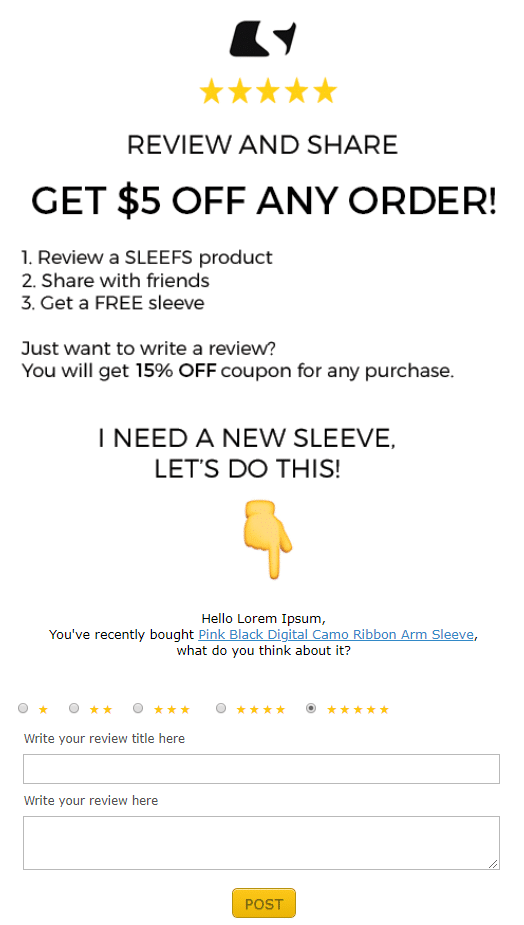
In addition to the entry method, rewards are likewise up to you. Beyond actual prizes, dollar-off amounts for future purchases are common.
Percentage-off discounts are popular, too. This way you can encourage reviews and repeat business at the same time.
Also, keep in mind that product reviews and business reviews are two completely different animals. Most eCommerce product review sites are much more lax when it comes to incentivizing reviews.
Of course, there’s fine print to go through any sort of contest (particularly those dealing with social media or UGC). That’s why some businesses prefer to use a dedicated platform such as Shortstack rather than run a contest “by hand.”
Also, keep in mind that asking explicitly for reviews means doing some homework. Not every platform is created equal in terms of how they tolerate asking customers for reviews. For example, conventional wisdom tells us it’s fine for Google, but you shouldn't solicit reviews on Yelp.
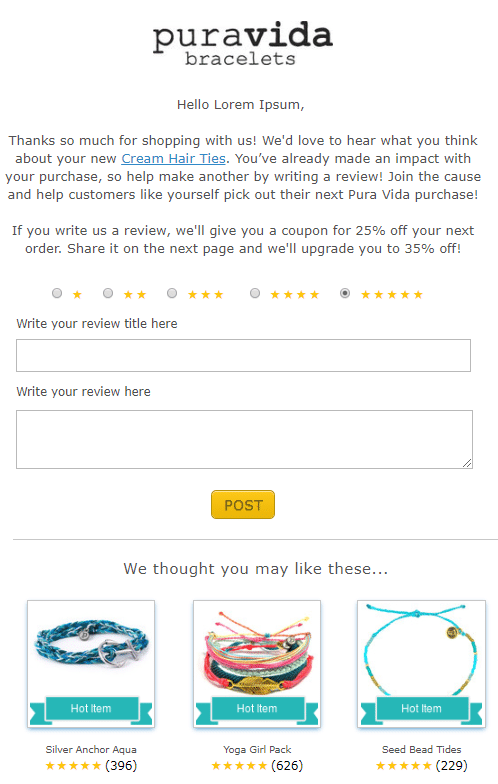
And that sort of “direct approach” leads us to our last point!
6. When in Doubt, Just Ask (But Do It The Right Way)
If you want something from your customers, sometimes it’s best to just ask.
Nothing fancy, either. Just good, old-fashioned outreach via email.
Whether through autoresponders or manually, asking for feedback directly can be surprisingly effective if it’s done in a tasteful and creative way. Here are a few review request templates you can swipe from to help frame your request as something compelling.
For example, this template works off the basis that your competitor did your customer wrong and you’re looking to avoid the same pitfalls.

This tactic sees you buttering your customers up: this goes hand in hand with our segmentation strategy noted above.

Finally, the “we want to make it better” approach is always a safe bet. This particular template directly tells readers what to do and stresses that the process is painless.

These sorts of emails frame your outreach as something meaningful that will benefit both parties. This is the exact kind of incentive people need to generate the reviews you deserve.
And with that, we wrap up our list!
How Are You Using Email to Rev Up Your Reviews?
The more places you have to score those ever-so-valuable ratings and reviews, the better.
Email is a fantastic avenue for making it happen. This is especially true as tasks such as asking for reviews can be put on autopilot.
And the beauty of email is that you can fine-tune your efforts over time.
Want to figure out what pitches work best? Looking to experiment with the frequency of your requests and follow-ups? No sweat: look at your campaign data.
The end result is more engagement with your current customers and a much-needed sense of trust with the ones meeting you for the first time.
In other words, a win-win.
About the Author
Emil Kristensen
Emil Kristensen is the CMO and co-founder of Sleeknote: a company that helps e-commerce brands engage their site visitors—without hurting the user experience.









